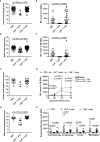Adoptive Transfer of Immune Cells Into RAG2IL-2Rγ-Deficient Mice During Litomosoides sigmodontis Infection: A Novel Approach to Investigate Filarial-Specific Immune Responses
- PMID: 34868049
- PMCID: PMC8636703
- DOI: 10.3389/fimmu.2021.777860
Adoptive Transfer of Immune Cells Into RAG2IL-2Rγ-Deficient Mice During Litomosoides sigmodontis Infection: A Novel Approach to Investigate Filarial-Specific Immune Responses
Abstract
Despite long-term mass drug administration programmes, approximately 220 million people are still infected with filariae in endemic regions. Several research studies have characterized host immune responses but a major obstacle for research on human filariae has been the inability to obtain adult worms which in turn has hindered analysis on infection kinetics and immune signalling. Although the Litomosoides sigmodontis filarial mouse model is well-established, the complex immunological mechanisms associated with filarial control and disease progression remain unclear and translation to human infections is difficult, especially since human filarial infections in rodents are limited. To overcome these obstacles, we performed adoptive immune cell transfer experiments into RAG2IL-2Rγ-deficient C57BL/6 mice. These mice lack T, B and natural killer cells and are susceptible to infection with the human filaria Loa loa. In this study, we revealed a long-term release of L. sigmodontis offspring (microfilariae) in RAG2IL-2Rγ-deficient C57BL/6 mice, which contrasts to C57BL/6 mice which normally eliminate the parasites before patency. We further showed that CD4+ T cells isolated from acute L. sigmodontis-infected C57BL/6 donor mice or mice that already cleared the infection were able to eliminate the parasite and prevent inflammation at the site of infection. In addition, the clearance of the parasites was associated with Th17 polarization of the CD4+ T cells. Consequently, adoptive transfer of immune cell subsets into RAG2IL-2Rγ-deficient C57BL/6 mice will provide an optimal platform to decipher characteristics of distinct immune cells that are crucial for the immunity against rodent and human filarial infections and moreover, might be useful for preclinical research, especially about the efficacy of macrofilaricidal drugs.
Keywords: CD4+ and CD8+ T cells; Filariae; Litomosoides sigmodontis; Th17 polarization; adoptive transfer; anti-filarial immunity.
Copyright © 2021 Wiszniewsky, Layland, Arndts, Wadephul, Tamadaho, Borrero-Wolff, Chunda, Kien, Hoerauf, Wanji and Ritter.
Conflict of interest statement
The authors declare that the research was conducted in the absence of any commercial or financial relationships that could be construed as a potential conflict of interest.
Figures







Similar articles
-
Development of patent Litomosoides sigmodontis infections in semi-susceptible C57BL/6 mice in the absence of adaptive immune responses.Parasit Vectors. 2015 Jul 25;8:396. doi: 10.1186/s13071-015-1011-2. Parasit Vectors. 2015. PMID: 26209319 Free PMC article.
-
Patency of Litomosoides sigmodontis infection depends on Toll-like receptor 4 whereas Toll-like receptor 2 signalling influences filarial-specific CD4(+) T-cell responses.Immunology. 2016 Apr;147(4):429-42. doi: 10.1111/imm.12573. Immunology. 2016. PMID: 26714796 Free PMC article.
-
Absence of IL-17A in Litomosoides sigmodontis-infected mice influences worm development and drives elevated filarial-specific IFN-γ.Parasitol Res. 2018 Aug;117(8):2665-2675. doi: 10.1007/s00436-018-5959-7. Epub 2018 Jun 22. Parasitol Res. 2018. PMID: 29931394 Free PMC article.
-
The immune response of inbred laboratory mice to Litomosoides sigmodontis: A route to discovery in myeloid cell biology.Parasite Immunol. 2020 Jul;42(7):e12708. doi: 10.1111/pim.12708. Epub 2020 Mar 21. Parasite Immunol. 2020. PMID: 32145033 Free PMC article. Review.
-
Human filariasis-contributions of the Litomosoides sigmodontis and Acanthocheilonema viteae animal model.Parasitol Res. 2021 Dec;120(12):4125-4143. doi: 10.1007/s00436-020-07026-2. Epub 2021 Feb 6. Parasitol Res. 2021. PMID: 33547508 Free PMC article. Review.
Cited by
-
ILC2s Control Microfilaremia During Litomosoides sigmodontis Infection in Rag2-/- Mice.Front Immunol. 2022 Jun 9;13:863663. doi: 10.3389/fimmu.2022.863663. eCollection 2022. Front Immunol. 2022. PMID: 35757689 Free PMC article.
-
Host genetic backgrounds: the key to determining parasite-host adaptation.Front Cell Infect Microbiol. 2023 Aug 10;13:1228206. doi: 10.3389/fcimb.2023.1228206. eCollection 2023. Front Cell Infect Microbiol. 2023. PMID: 37637465 Free PMC article. Review.
-
New paradigms in research on Dirofilaria immitis.Parasit Vectors. 2023 Jul 21;16(1):247. doi: 10.1186/s13071-023-05762-9. Parasit Vectors. 2023. PMID: 37480077 Free PMC article. Review.
-
T helper 2 cells control monocyte to tissue-resident macrophage differentiation during nematode infection of the pleural cavity.Immunity. 2023 May 9;56(5):1064-1081.e10. doi: 10.1016/j.immuni.2023.02.016. Epub 2023 Mar 21. Immunity. 2023. PMID: 36948193 Free PMC article.
-
Dirofilariasis mouse models for heartworm preclinical research.Front Microbiol. 2023 Jun 22;14:1208301. doi: 10.3389/fmicb.2023.1208301. eCollection 2023. Front Microbiol. 2023. PMID: 37426014 Free PMC article.
References
-
- World Health Organization . Global Programme to Eliminate Lymphatic Filariasis: Progress Report, 2019. Wkly Epidemiol Rec (2020) 95:509–24.
-
- World Health Organization . Progress Report on the Elimination of Human Onchocerciasis, 2019-2020. Wkly Epidemiol Rec (2020) 95:545–54.
-
- Traore MO, Sarr MD, Badji A, Bissan Y, Diawara L, Doumbia K, et al. . Proof-Of-Principle of Onchocerciasis Elimination With Ivermectin Treatment in Endemic Foci in Africa: Final Results of a Study in Mali and Senegal. PLoS Negl Trop Dis (2012) 6:e1825. doi: 10.1371/journal.pntd.0001825 - DOI - PMC - PubMed
Publication types
MeSH terms
Substances
LinkOut - more resources
Full Text Sources
Molecular Biology Databases
Research Materials

